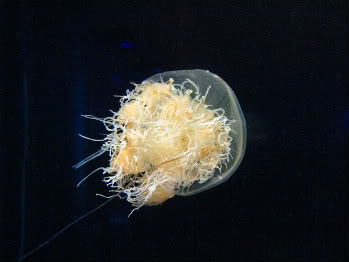|
|
A ‘monoculture of jellyfish’ threatens the oceans as we know them.
It could be a plot of a (bad) science-fiction film: a man-made disaster creates spawns of millions upon millions of jellyfish which rapidly take over the ocean. Humans, starving for mahi-mahi and Chilean seabass, turn to jellyfish, which becomes the new tuna (after the tuna fishery has collapsed, of course). Fish sticks become jelly-sticks, and fish-and-chips becomes jelly-and-chips. The sci-fi film could end with the ominous image of a jellyfish evolving terrestrial limbs and pulling itself onto land—readying itself for a new conquest.
While this scenario sounds ridiculous, all of it—except the last sentence, of course—could conceivably come to pass. Dr. Anthony Richardson calls this the ‘jellyfish joyride’ and it is already happening in parts of the ocean: diverse fish populations are being replaced by jellyfish.
 A nemopilema nomurai in the Osaka Aquarium. Giant nomura jellyfish have appeared in massive blooms in Japanese seas. Photo by Kenpei. |
“Dense jellyfish aggregations can be a natural feature of healthy ocean ecosystems, but a clear picture is now emerging of more severe and frequent jellyfish outbreaks worldwide,” Richardson, from the University of Queensland and CSIRO Climate Adaptation Flagship, explains. “In recent years, jellyfish blooms have been recorded in the Mediterranean, the Gulf of Mexico, the Black and Caspian Seas, the Northeast US coast, and particularly in Far East coastal waters.”
Once jellyfish gain a foothold, Richardson says that if conditions are right they can establish a massive population at the expense of other ocean life: “the problem is that jellyfish might form an alternative ‘stable state’. What this means is that parts of the ocean might switch from being dominated by fish to being dominated by jellyfish.”
In a new study appearing in Trends in Ecology and Evolution, Richardson and colleagues explore the causes behind the jellyfish infestation and the need for swift, decisive action to stem the jellyfish take-over. Jellyfish explosions are linked directly to human actions, including over-fishing, the input of fertilizer and sewage into the ocean, and climate change.
The rest of this article is now only available to subscribers. An updated version is also published in Jeremy Hance’s book, Life is Good: Conservation in an Age of Mass Extinction, which was released in January 2012.
CITATION: Anthony J. Richardson, Andrew Bakun, Graeme C. Hays, and Mark J. Gibbons. The jellyfish joyride: causes, consequences and management responses to a more gelatinous future. Trends in Ecology and Evolution. June 2009, Volume 24, Number 6.
Related articles
Giant sea creatures discovered in Antarctica
(03/21/2008) An eight week long survey of New Zealand’s Antarctic waters has turned up giant creatures including jellyfish with 12-foot tentacles and 2-foot-wide starfish, as well as up to eight previously undiscovered species of mollusc, reports the Associated Press (A.P.).
Black jellyfish, strange marine species discovered in deep ocean
(10/17/2007) An expedition to an unexplored deep ocean basin south of the Philippine Islands has turned up a trove of previous undiscovered species including a black jellyfish, a transparent sea cucumber, and a tentacled worm that resembles a squid.